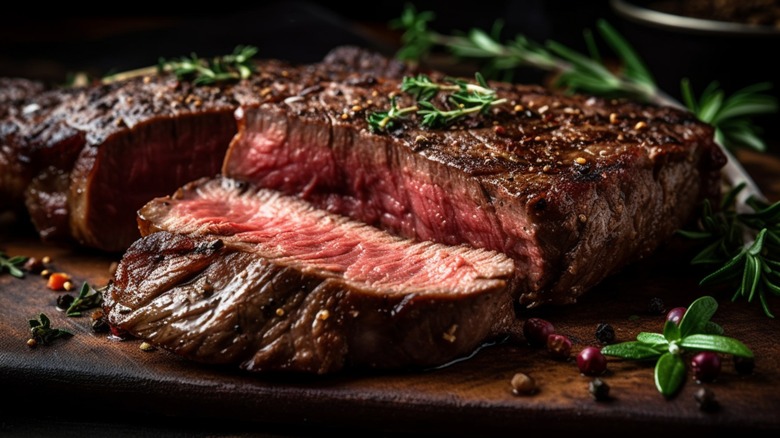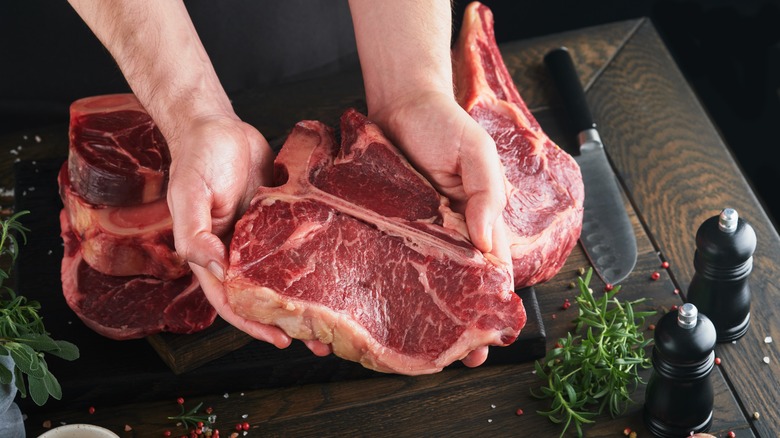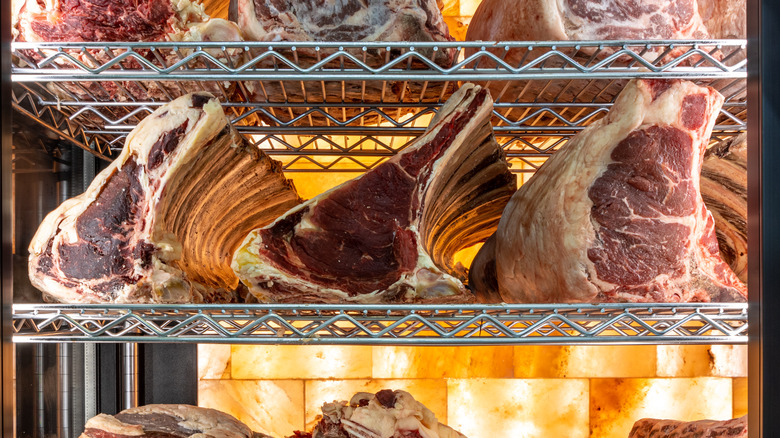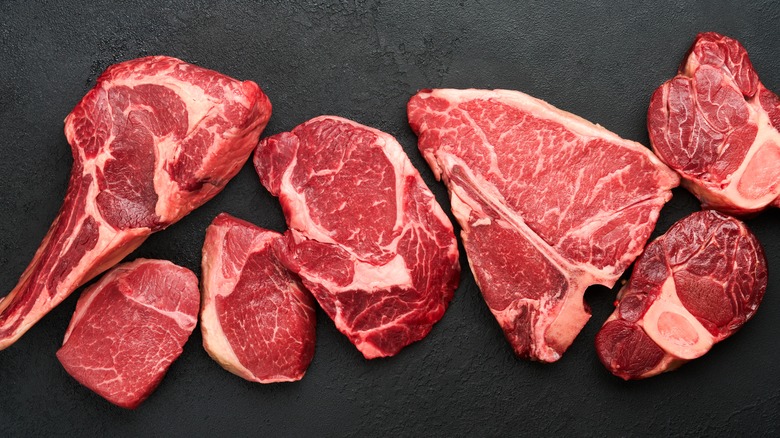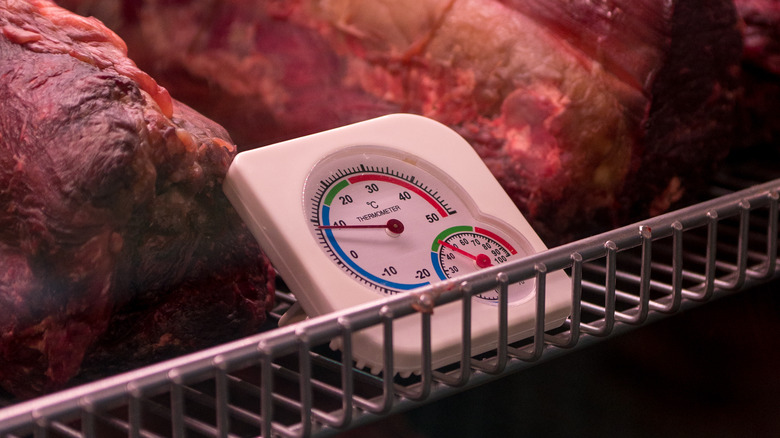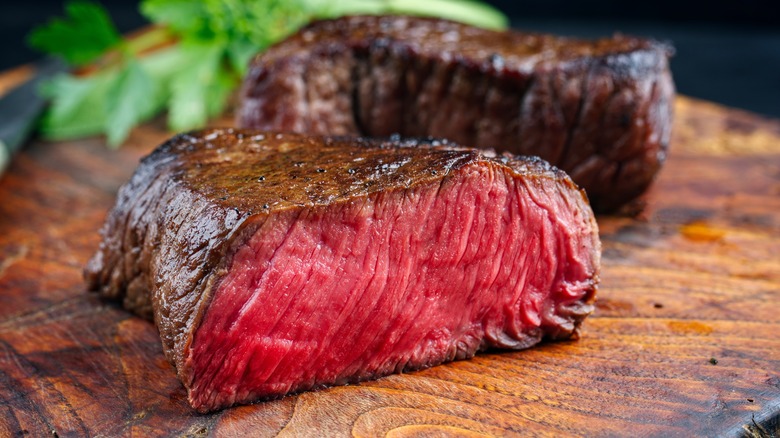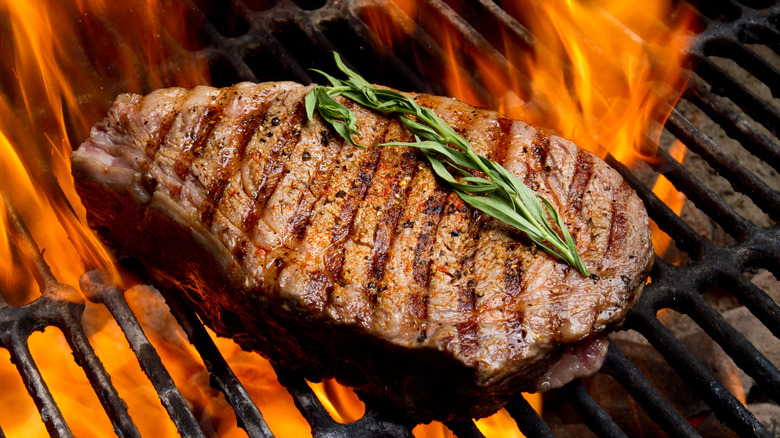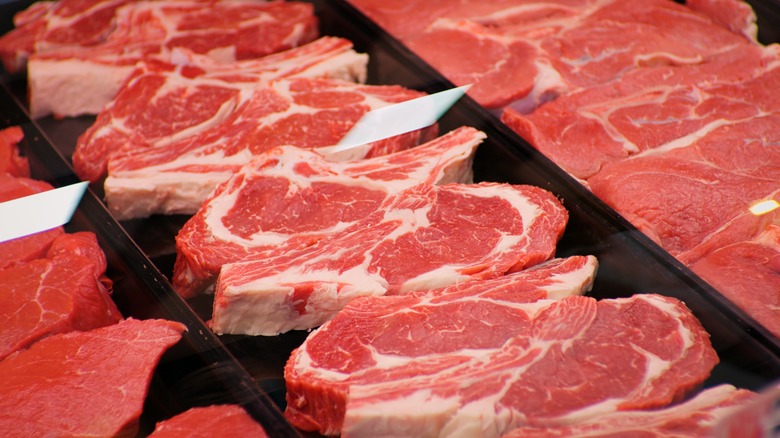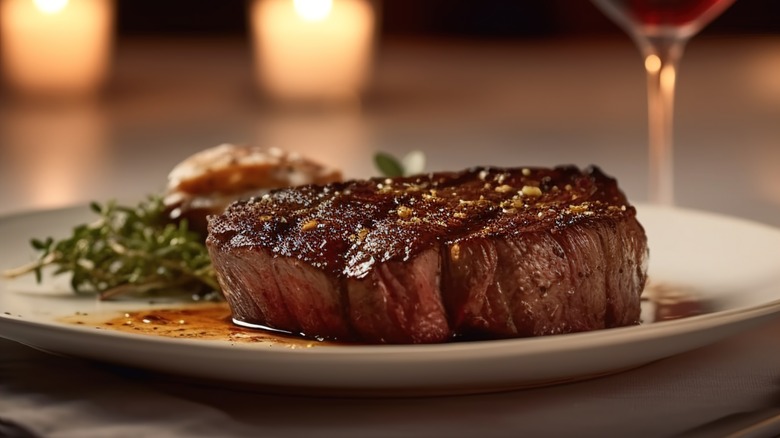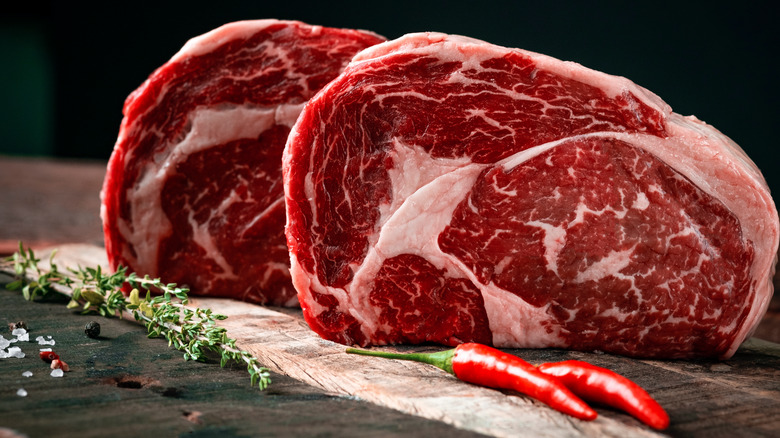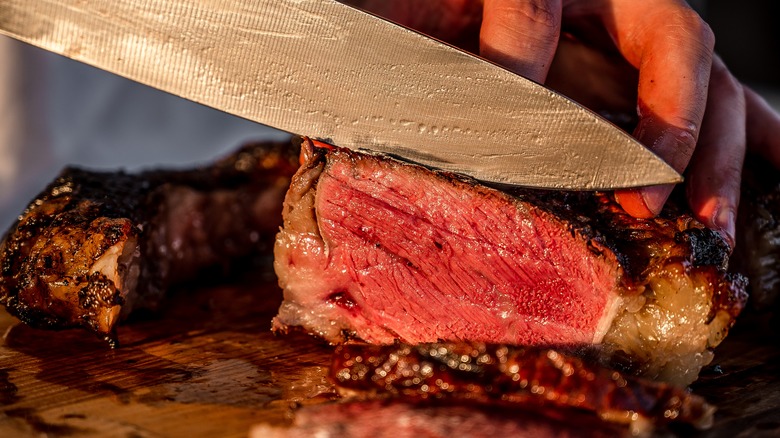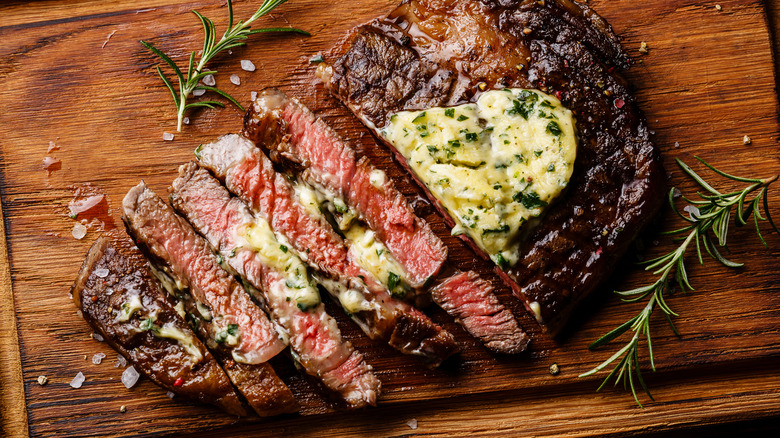Chefs Weigh-In On The Ultimate Guide To Dry-Aging Steak At Home
If you're a serious carnivore, there's a good chance you know your way around a grill and have your favorite butcher on speed dial. But when you're in the mood for a good dry-aged steak, there's an even better chance that the only thing you've ever made were reservations to your favorite steakhouse chain. Yes, it will be pricey, even by fancy steakhouse standards. But you know your meal will be a special experience.
And as a meat nerd, you understand why you pay a premium for dry-aged steaks. Steakhouses that offer them not only start with high-quality meat — which is already expensive — but age the steaks in special, climate-controlled lockers for weeks; often a month or even more. Aging transforms the meat, making it both more tender and more complex in flavor, lending funky, gamy, umami notes that some meat lovers crave. This has inspired curious carnivores to try dry aging steaks themselves at home, both for potential money-saving opportunities and bragging rights. But while you can only get the true flavor of long-aged meat if you start with professional equipment, large cuts of meat, and lots of time, you can get some of its benefits with ordinary kitchen equipment and a few good-quality steaks. Here are some tips from the pros to get you started.
The best way to prepare steaks for dry aging
To understand how to best prepare steaks for dry aging, you must first understand how dry aging works and how it affects the taste and texture of meat. As its name implies, dry aging is a process in which meat is aged in a cool, open-air (dry) environment. The dry-aging process transforms the meat in a number of ways. First, it causes the meat to lose moisture, which concentrates its flavor — the hard rind that forms on the surface of long-aged meat is a side effect of this process. Second, as the proteins in the meat break down over time, the meat becomes more tender. Finally, over time, the meat's enzymes, along with ambient bacteria in the meat locker, transform its flavor to make it a deeper, funkier version of itself.
Thus, you should do what you can to help the process along before you start aging your steaks. "The best thing to do before dry aging is make sure to pat the protein dry," said Parker Brown, executive chef at Ten Rooms in Tampa. "Make sure you have enough refrigerated space that is not overcrowded. A separate refrigerator or dry ager is always preferred." These steps will ensure the meat gets plenty of exposure to cool air to facilitate the drying process.
Helpful equipment for dry aging steak at home
While high-end steakhouses and meat purveyors use dedicated, temperature-controlled meat lockers for dry aging, intrepid recipe developers have devised simplified dry aging techniques for home cooks that involve just some space in your regular refrigerator. And a huge advantage of these methods is they only require basic kitchen gear that most proficient home cooks already have on hand.
A critical tool for home dry aging, also employed by the pros, is the humble wire rack. "When it comes to dry aging, airflow is your friend," explains chef Ashish Alfred, owner of the Alfred Restaurant Group. "Utilize a wire rack to ensure proper circulation around your steaks, resulting in a more uniform aging process with even flavor distribution." Also critical for successful dry aging are temperature and humidity control. "For a successful DIY setup, focus on three key factors: temperature, humidity, and circulation," recommends Chef Michael Ferraro of Abe & Louie's in Boca Raton. "Use an inexpensive portable fan for circulation, maintain humidity between 75-85%, and set the temperature between 30-40 degrees Fahrenheit."
How long to dry age steak at home
While some dry-aging formulas for home cooks call for letting steaks rest uncovered in the fridge for as little as three or four days, professional chefs and butchers typically age meat for much longer — typically around 30 days. Beyond that, aged meat develops a much stronger flavor and aroma that may be too intense for many diners. But for serious fans of dry-aged steak, the flavor only improves with age.
So, how long should you age your steak? It depends on your taste — the longer your steaks age, the more distinctive their flavor. "Two weeks can yield results, but 60 days is ideal!" recommends Scott Franqueza, executive chef at High Hampton Resort in Cashiers, NC. Some chefs go even longer. "We age things eight, nine, 10 months, and people love it," said chef John Tesar of Knife Steakhouse in Dallas and Plano, TX. But bear in mind that long-aged steaks are an acquired taste, and if you're not already a fan of gamy, funky foods (such as aged cheeses), months-old steaks may not be for you. "Any longer than 60 days is going to be a very aggressive flavor profile," warned chef Mike Saperstein, co-owner of Sunshine Provisions.
Ideally, you should use a dedicated refrigerator for dry aging
While your kitchen fridge can work for occasional dry-aging experiments, the experts agree that for the best and most consistent results, a separate refrigerator just for dry aging is ideal. So, if you love dry-aged meat and see yourself preparing a lot of it, this may be a worthwhile investment. A big reason for keeping dry-aging meat in its own fridge is to prevent it from picking up odors or bacteria from other food. "If you have [your meat] in the refrigerator with other products, the meat will pick up those flavors," Saperstein warned.
Another advantage to a dedicated refrigerator — especially if you invest in a model specifically made for aging meat — is more precise temperature and humidity control. "Buy a Dry Ager cabinet, which will have a preset function and is the easiest method with little to no thinking needed," Saperstein suggested. "While this certainly is the easiest, it's also the most expensive and will run anywhere from $700 up to the thousands. But you'll have it forever." A less expensive alternative is a regular mini fridge with a glass door, which will allow you to monitor the meat without opening the door. This will keep bacteria out and help you avoid changing the temperature inside the fridge.
Don't worry about mold on the outside of dry-aged meat
If you've never seen dry-aged meat before, the sight of a fully aged slab direct from a steakhouse meat locker doesn't inspire confidence. Indeed, your first response may be a gag reflex: The meat will be dark, hard, and leathery on the outside and perhaps covered with mold. Fear not; this is exactly how it's supposed to look (and don't worry, cooks and butchers trim off all the funky bits on the outside before they cut the meat's tender interior into serving-size portions). Believe it or not, the mold on the outside of dry-aged beef helps define the flavor of dry-aged steak. "Embrace a little mold; it can add depth of flavor, similar to aged cheeses," suggested Chad Johnson, executive chef at Bern's Steak House in Tampa.
"What people don't understand is that mold is really the saving grace, but you have to grow the right mold," explained chef John Tesar. "You have to procure it from somewhere or start it from something. It will not just occur to the degree that will be worthwhile in one of those at-home dry aging boxes." In fact, Tesar often gives mold from the restaurant's meat locker to interested home cooks. "I give mold to people all the time, so if people want mold, give me a call," Tesar quipped. "That is the key to home dry aging, getting the right mold."
The best cuts for dry aging at home
While it's possible to dry-age a range of proteins, from chicken to fish, beef is the most common choice — but not just any beef will do. "If you start out with the wrong steak, you are setting yourself up for disappointment," warned Ashish Alfred. "Dry aging truly shines with cuts like ribeye, strip loin, or sirloin because of their generous amount of intramuscular fat, also known as marbling. This fat content isn't just for show — it's what brings out the rich, complex flavors and ensures a tender, melt-in-your-mouth texture as the steak ages."
John Tesar agrees. "If you are talking about beef, the only worthwhile cuts to do are ribeye and sirloin," Tesar said. "And they need to be fully capped to reduce loss and also to enhance flavor because that fat and all that bone and the collagen is really a protector, and it's also flavor motivator. That's where the flavor really comes from."
When it comes to steaks for dry aging, quality counts
If you plan to invest all the time and effort to dry age steaks at home, you want to aim for steakhouse-level quality. And to attain steakhouse-level quality, there's no way around it — you need to invest in steakhouse-quality meat. Since much of the flavor of steak comes from the flavor of its fat, you'll want meat with a generous amount of marbling — which means prime meat if you can obtain it. "When it comes to quality, it's all about starting strong. Start with high-quality beef, preferably prime-grade, to ensure rich flavor and tenderness," Alfred said. Michael Ferraro agrees: "At Abe & Louie's Boca Raton, we only use top-quality USDA Prime cuts, and I recommend the same for home aging."
Freshness is also key to ensuring dry-aging success. "Use non-aged meat as fresh as possible; do not used wet-aged meat if possible," Saperstein recommended. We're not going to lie, it will be pricey — but the end results will be totally worth it.
Common mistakes when dry aging at home
There are plenty of common mistakes when cooking steaks, but dry aging, like wine-making, is largely about watchful waiting. "Aging steaks effectively requires attention to detail and patience," Chad Johnson said. Your main job is to choose the right meat, find an appropriate place to age it, and keep an eye on the temperature and humidity of the cooler as the meat ages. Thus, one of the biggest mistakes home cooks can make is to ignore these important factors. "Temperature and humidity control are non-negotiables in dry aging," Alfred said. "I've learned this through trial and error, realizing that even slight deviations can impact the final product." The chef recommends investing in equipment that lets you precisely regulate and keep your fridge running at around 34-38 degrees Fahrenheit with humidity levels between 75-85%.
And while it's a good idea to keep a close watch on your meat as it ages, avoid the temptation to poke it or play with it during the process. "I get it, the temptation to check on your steaks every hour is real," Alfred notes, "but trust the process and resist the urge. Your meat needs its space to work its magic." Johnson concurs: "Refrain from constantly checking progress to prevent introducing bacteria."
Safety tips for dry aging at home
Fully dry-aged steaks from a good restaurant or high-end butcher may be delicious, but the process itself can make some people a bit uncomfortable. We've all been taught that fresh meat should be kept in the refrigerator for three to five days at most, so what's the deal with dry-aging meat for a month or more?
For safe, dry aging, careful climate control is crucial: Conditions that will keep a steak fresh for a couple of days may not be safe conditions for longer-term dry aging. "Too high of a humidity and too high of temperature will create an environment where bacteria will grow. This will cause decay and can lead to food born illnesses," Scott Franqueza warned. Cleanliness is also critical for safe dry aging. "It may sound like a small detail, but ensuring your tools and surfaces are squeaky clean sets the stage for a successful aging process," Ashish Alfred said. Finally, trust your nose and your common sense: Dry-aged steak can have a touch of mold and a pleasantly funky odor, but if your aged steak smells just wrong, don't eat it. "Excessive mold or off-putting odors are signs of spoilage and indicate that the steak should be discarded," Alfred noted.
Advice for those who've never tried dry aging before
The idea of dry aging at home can seem a bit intimidating: You're basically taking an expensive piece of meat and allowing it to undergo controlled decomposition in your refrigerator over the course of several weeks or months. And if you screw up, the risk of ending up with a rotten piece of meat — or worse, a case of food poisoning — is real.
To ensure success on your first try, it's a good idea to get some expert guidance. Having a knowledgeable mentor nearby to answer your questions can give you peace of mind. "Talk to someone who has done it before," John Tesar said. Also, expect your dry-aged steak to look, feel, and smell different than a fresh steak. "The outer layer of the steak will develop a dark crust or pellicle during the aging process," Alfred explained. The crust is what helps protect the meat and lock in flavor, and it's a good indicator that your steak is on the right track. Finally, while precision and attention to detail — especially when it comes to temperature and humidity — are critical for dry-aging success, understand that each dry-aging project will be different. "Remember, dry aging is as much about intuition as it is about technique," Alfred said. "Embrace the process, trust your instincts, and above all, savor the journey."
The best ways to cook and serve dry-aged steak
A successfully dry-aged steak will have a distinctive smell, which you can use to determine if it's ready to eat. "Aged meat should smell earthy and robust, similar to mushrooms or cheese," Michael Ferraro said. In addition, a good aged steak will feel different than a fresh steak. "Dry-aged steaks develop a firmer texture as they age because of moisture loss," Alfred explained. Press gently on the surface of the steak — if it feels firm and slightly dry to the touch, it's a sign that the aging process is working its magic."
The fact that dry-aged steaks are indeed drier than fresh steaks means you'll need to cook them a little differently than similar fresh steaks. "Be mindful not to overcook; aged beef has lower moisture content, so adjust cooking times accordingly for a more succulent result," Johnson advised. "If you normally eat a medium steak, try medium rare." Since the process of aging breaks down the collagen that holds muscle fibers together, cuts of steak that typically benefit from additional cooking to tenderize them can be eaten at a lower finished temperature.

